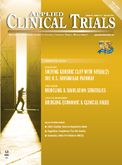Safety Considerations for Follow-On Non-Biologic Complex Drugs
Applied Clinical Trials
With patents for many NBCDs soon to expire, the need for regulatory guidance regarding follow-on versions of these products is crucial.
Biologic drugs and non-biologic complex drugs (NBCDs) have revolutionized the treatment of many difficult-to-treat diseases including cancer, multiple sclerosis, and chronic iron deficiency. Biologic drugs are derived from living sources, such as microorganisms. NBCDs are produced by chemical synthesis, rather than from a living source; however, like many biologic drugs, the active ingredients in NBCDs typically comprise complex heterogenous (but closely related) nanomolecular components that cannot be isolated, fully quantitated, or completely characterized–even when using state of the art physicochemical analytical tools. Additionally, NBCDs may have multiple or unknown modes of therapeutic activity.
Patents for many biologics and NBCDs are soon expiring and drug manufacturers are actively working
Scott Kolodny

toward producing biosimilar drugs and follow-on versions of NBCDs. The FDA has issued three final guidances for development of biosimilars based on feedback from pharmaceutical and biotech companies, researchers, and patient and physician groups. On March 6, Zarxio (filgrastim-sndz) became the first biosimilar product to receive marketing approval from FDA. Currently, no FDA guidance is available regarding regulatory requirements to ensure the safety and effectiveness of follow-on versions of NBCDs. While nonbiologic, small-molecule, generic drug approval is based on long-established, clearly-defined regulatory requirements, regulators must carefully consider the applicability of “pharmaceutical sameness” to follow-on NBCDs as their regulatory approval pathway is defined.
Generic drugs cost less than branded drugs because their approval does not require clinical testing. In the classic approach, a generic drug must be shown to have an active ingredient that is identical to that of the reference drug and to have the same mechanism of action. However, in the case of NBCDs, two drugs cannot be shown to have identical active substances if the active substance has not been fully identified, nor can they demonstrate the same mechanism of action if it remains unknown or not fully elucidated. Importantly, the identity and quality of NBCDs are contingent on their well-controlled (often proprietary) manufacturing process. Follow-on NBCDs that are manufactured differently from the original branded product could have minute structural or compositional differences from the original product that are undetectable but might compromise product safety.
Despite these caveats, the FDA has accepted abbreviated new drug applications for follow-on NBCD products. This concerns many physicians and other medical experts because a follow-on NBCD may have difficult-to-detect differences from the original drug that cause serious safety problems that only come to light after the drug is marketed. Concern is amplified for physicians who treat patients with chronic autoimmune diseases such as multiple sclerosis, in which a slight change to a previously successful immunogenic therapy could prompt serious adverse events or compromise long-term effectiveness.
To ensure the safety and quality of follow-on versions of NBCDs, FDA should require Phase III clinical trials with relevant safety and efficacy endpoints. Further, once follow-on NBCDs are available, comprehensive post-marketing surveillance and risk-assessment programs should be in place to capture drug side effects that may not be evident in 1- or 2-year clinical trials.
Scott Kolodny, MD, is Global Senior Medical Director for Multiple Sclerosis, Teva Pharmaceuticals
